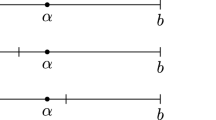Abstract
This paper discusses a class of quadratic immersed finite element (IFE) spaces developed for solving second order elliptic interface problems. Unlike the linear IFE basis functions, the quadratic IFE local nodal basis functions cannot be uniquely defined by nodal values and interface jump conditions. Three types of one dimensional quadratic IFE basis functions are presented together with their extensions for forming the two dimensional IFE spaces based on rectangular partitions. Approximation capabilities of these IFE spaces are discussed. Finite element solutions based on these IFE for representative interface problems are presented to further illustrate capabilities of these IFE spaces.
Similar content being viewed by others
References
I. Babu \(\mbox{\v{s}}\) ka, The finite element method for elliptic equations with discontinuous coefficients, Computing 5 (1970) 207–213.
I. Babu \(\mbox{\v{s}}\) ka and J.E. Osborn, Generalized finite element methods: their performance and relation to mixed methods, SIAM J. Numer. Anal. 20(3) (1983) 510–536.
I. Babu \(\mbox{\v{s}}\) ka and J.E. Osborn, Finite element methods for the solution of problems with rough input data, in: Singular and Constructive Methods for their Treatment, eds. P. Grisvard, W. Wendland and J.R. Whiteman, Lecture Notes in Math., Vol. 1121 (Springer, New York, 1985) pp. 1–18.
D. Braess, Finite Elements (Cambridge University Press, 1997).
J.H. Bramble and J.T. King, A finite element method for interface problems in domains with smooth boundary and interfaces, Preprint (1995).
S.C. Brenner and L. Ridgeway Scott, The Mathematical Theory of Finite Element Methods, Texts in Appl. Math., Vol. 15 (Springer, New York, 1994).
Z. Chen and J. Zou, Finite element methods and their convergence for elliptic and parabolic interface problems, Numer. Math. 79 (1998) 175–202.
A. Dadone and B. Grossman, Progressive optimization of inverse fluid dynamic design problems, Comput. Fluids 29 (2000) 1–32.
A. Dadone and B. Grossman, An immersed body methodology for inviscid flows on Cartesian grids, AIAA Paper 2002-1059 (2002).
R. Ewing, Z. Li, T. Lin and Y. Lin, The immersed finite volume element method for the elliptic interface problems, Math. Comput. Simulation 50 (1999) 63–76.
B. Heinrich, Finite Difference Methods on Irregular Networks, Internat. Ser. Numer. Math., Vol. 82 (Birkhäuser, Boston, 1987).
D.W. Hewett, The embedded curved boundary method for orthogonal simulation meshes, J. Comput. Phys. 138 (1997) 585–616.
C. Johnson, Numerical Solution of Partial Differential Equations by the Finite Element Method (Cambridge Univ. Press, Cambridge, 1987).
R.J. LeVeque and Z. Li, The immersed interface method for elliptic equations with discontinuous coefficients and singular sources, SIAM J. Numer. Anal. 34 (1994) 1019–1044.
Z. Li, The immersed interface method using a finite element formulation, Appl. Numer. Math. 27 (1998) 253–267.
Z. Li, T. Lin, Y. Lin and R. Rogers, An immersed finite element space and its approximation capability, Numer. Methods Partial Differential Equations (2003).
Z. Li, T. Lin and X. Wu, New cartesian grid methods for interface problems using finite element formulation, Numer. Math. 96 (2003) 61–98.
T. Lin, Y. Lin, R.C. Rogers and L.M. Ryan, A rectangular immersed finite element method for interface problems, in: Advances in Computation: Theory and Practice, Vol. 7 (2001) pp. 107–114.
T. Lin and J. Wang, An immersed finite element electric field solver for ion optics modeling, in: Proceedings of AIAA Joint Propulsion Conference, Indianapolis, IN, July 2002, AIAA Paper 2002-4263 (2002).
C.S. Peskin, Numerical analysis of blood flow in the heart, J. Comput. Phys. 25 (1977) 220–252.
C.S. Peskin, Lectures on Mathematical Aspects of Physiology, in: Lectures in Appl. Math., Vol. 19 (Amer. Math. Soc., Providence, RI, 1981) pp. 69–107.
M.P. Robinson and G. Fairweather, Orthogonal spline collocation methods for Schrödinger-type equations in one space variable, Numer. Math. 68 (1994) 355–376.
A.A. Samarski \(\mbox{\v{i}}\) and V.B. Andreev, Méthods aux différences pour équations elliptiques (Mir, Moscow, 1978).
S. Zhu, G. Yuan and W. Sun, Convergence and stability of explicit/implicit schemes for parabolic equations with discontinuous coefficients, Internat. J. Numer. Anal. Modelling (2004).
Author information
Authors and Affiliations
Additional information
Communicated by Yuesheng Xu
Dedicated to the 60th birthday of Charles A. Micchelli
Mathematics subject classifications (2000)
65N15, 65N30, 65N50, 65Z05.
Yanping Lin: Supported by NSERC.
Weiwei Sun: This work was supported in part by a grant from the Research Grants Council of the Hong Kong Special Administrative Region, China (project CityU 1141/01P).
Rights and permissions
About this article
Cite this article
Camp, B., Lin, T., Lin, Y. et al. Quadratic immersed finite element spaces and their approximation capabilities. Adv Comput Math 24, 81–112 (2006). https://doi.org/10.1007/s10444-004-4139-8
Received:
Accepted:
Issue Date:
DOI: https://doi.org/10.1007/s10444-004-4139-8




